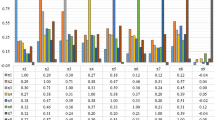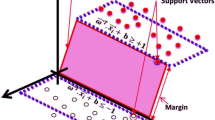Abstract
Breast cancer is the biggest curse for the women society in the world since the survival factor of the infected patients is ensured only when it is detected at the early localized stage. The majority of the intelligent schemes proposed for detecting the breast cancer relies on the human skill that helps in trustworthy determination of essential pattern that confirms the existence of the infected cancer cells for deciding upon the course of treatment. Further, most of the research works contributed in the literature for detecting breast cancer necessitates huge time and laborinvolved that increases the time of diagnosis. This Intelligent Artificial Bee Colony and Enhanced Monarchy Butterfly Optimization Technique (IABC-EMBOT) is proposed for effective breast cancer diagnosis. The core idea behind the formulation of IABC-EMBOT relies on two significant ameliorations that, i) focuses on the modification of Monarchy Butterfly Optimization that enhances the exploration degree based on the rate of exploitation of the searching space and ii) concentrates on the elimination in the limitations of the ABC scheme by enhancing the possibility of search diversification process through phenomenal update facilitated through the dynamic and adaptive butterfly operator that improves the search globally. The proposed IABC-EMBOT scheme investigated using the Wisconsin data set is proven to facilitate an improved average classification accuracy of 97.53%.






Similar content being viewed by others
References
Bick, U., Intensified Surveillance for Early Detection of Breast Cancer in High-Risk Patients. Breast Care 10(1):13–20, 2015.
Reinisch, M., Ataseven, B., and Kümmel, S., Neoadjuvant Dose-Dense and Dose-Intensified Chemotherapy in Breast Cancer - Review of the Literature. Breast Care 11(1):13–20, 2016.
Almeida, L. M., and Ludermir, T. B., A multi-objective memetic and hybrid methodology for optimizing the parameters and performance of artificial neural networks. Neurocomputing 73(7-9):1438–1450, 2010.
Abdel-Zaher, A. M., and Eldeib, A. M., Breast cancer classification using deep belief networks. Expert Syst. Appl. 46(2):139–144, 2016.
Uthoff, J., and Sieren, J. C., Information theory optimization based feature selection in breast mammography lesion classification. 2018 IEEE 15th International Symposium on Biomedical Imaging (ISBI 2018) 1(1):56–67, 2018.
Van der Waal, D., Verbeek, A. L., and Broeders, M. J., Breast density and breast cancer-specific survival by detection mode. BMC Cancer 18(1):67–78, 2018.
Agrawal, V., and Chandra, S., Feature selection using Artificial Bee Colony algorithm for medical image classification. 2015 Eighth International Conference on Contemporary Computing (IC3) 1(2):56–63, 2015.
Alshamlan, H. M., DQB: A novel dynamic quantitative classification model using an artificial bee colony algorithm with application on gene expression profiles. Saudi Journal of Biological Sciences 1(2):56–67, 2018.
Hasan, H., and Tahir, N. M., Feature selection of breast cancer based on Principal Component Analysis. 2010 6th International Colloquium on Signal Processing & its Applications 2(1):34–45, 2010.
Alshamlan, H. M., Badr, G. H., and Alohali, Y. A., ABC-SVM: Artificial Bee Colony and SVM Method for Microarray Gene Selection and Multi Class Cancer Classification. International Journal of Machine Learning and Computing 6(3):184–190, 2016.
Zainud-Deen, S., Hassen, W. M., Ali, E. M., Awadalla, K., and Sharshar, H., Breast cancer detection using a hybrid Finite difference frequency domain and particle swarm optimization techniques. 2008. National Radio Science Conference 2(1):88–99, 2008.
Arafi, A., Fajr, R., and Bouroumi, A., Breast cancer data analysis using support vector machines and particle swarm optimization. 2014 Second World Conference on Complex Systems (WCCS) 1(1):23–34, 2014.
Xu, H., Chen, T., Lv, J., and Guo, J., A combined parallel genetic algorithm and support vector machine model for breast cancer detection. Journal of Computational Methods in Sciences and Engineering 16(4):773–785, 2017.
Ahmad, F., Mat Isa, N. A., Hussain, Z., Osman, M. K., and Sulaiman, S. N., A GA-based feature selection and parameter optimization of an ANN in diagnosing breast cancer. Pattern. Anal. Applic. 18(4):861–870, 2014.
Belciug, S., and Gorunescu, F., A hybrid neural network/genetic algorithm applied to breast cancer detection and recurrence. Expert. Syst. 30(3):243–254, 2012.
Abdel-Zaher, A. M., and Eldeib, A. M., Breast cancer classification using deep belief networks. Expert Syst. Appl. 46(1):139–144, 2016.
Karthik, S., SrinivasaPerumal, R., and Chandra Mouli, P. V., Breast Cancer Classification Using Deep Neural Networks. Knowledge Computing and Its Applications 2(1):227–241, 2018.
Nazarian, M., Dezfouli, M. A., and Haronabadi, A., Classification of Breast Cancer Samples Through Using the Artificial Bee Colony Algorithm. International Journal of Computer Applications Technology and Research 2(5):522–525, 2013.
Zhang, X., Yang, J., and Nguyen, E., Breast cancer detection via Hu moment invariant and feedforward neural network. Proceedings of AIP Conference 2(1):56–65, 2018.
Sakri, S., Rashid, N. A., and Zain, Z. M., Particle Swarm Optimization Feature Selection for Breast Cancer Recurrence Prediction. IEEE Access 1(2):78–88, 2018.
Faris, H., Aljarah, I., and Mirjalili, S., Improved monarch butterfly optimization for unconstrained global search and neural network training. Appl. Intell. 48(2):445–464, 2017.
Arora, S., and Singh, S., An improved butterfly optimization algorithm with chaos. J. Intell. Fuzzy Syst. 32(1):1079–1088, 2017.
Wang, G., Deb, S., Zhao, X., and Cui, Z., A new monarch butterfly optimization with an improved crossover operator. Oper. Res. 1(1):54–66, 2016.
Alshamlan, H. M., Co-ABC: Correlation artificial bee colony algorithm for biomarker gene discovery using gene expression profile. Saudi Journal of Biological Sciences 1(1):23–36, 2018.
Wolberg, W. H., Street, W., Heisey, D. M., and Mangasarian, O. L., Computer-derived nuclear features distinguish malignant from benign breast cytology. Hum. Pathol. 26(7):792–796, 1995.
Wolberg, W. H., Street, W., and Mangasarian, O., Machine learning techniques to diagnose breast cancer from image-processed nuclear features of fine needle aspirates. Cancer Lett. 77(2-3):163–171, 1994.
Cheriguene, S., Azizi, N., Zemmal, N., Dey, N., Djellali, H., and Farah, N., Optimized Tumor Breast Cancer Classification Using Combining Random Subspace and Static Classifiers Selection Paradigms. Intelligent Systems Reference Library 1(1):289–307, 2015.
Zemmal, N., Azizi, N., Dey, N., and Sellami, M., Adaptive Semi Supervised Support Vector Machine Semi Supervised Learning with Features Cooperation for Breast Cancer Classification. Journal of Medical Imaging and Health Informatics 6(1):53–62, 2016.
Bhattacherjee, A., Roy, S., Paul, S., Roy, P., Kausar, N., and Dey, N., Classification Approach for Breast Cancer Detection Using Back Propagation Neural Network. Advances in Bioinformatics and Biomedical Engineering 1(1):210–221, 2016.
Zemmal, N., Azizi, N., Dey, N., and Sellami, M., Adaptative S3VM Semi Supervised Learning with Features Cooperation for Breast Cancer Classification. Journal of Medical Imaging and Health Informatics 6(4):957–967, 2016.
Kriti, V. J., Dey, N., and Kumar, V., PCA-PNN and PCA-SVM Based CAD Systems for Breast Density Classification. Intelligent Systems Reference Library 1(1):159–180, 2015.
Chakrabarty, S., Pal, A. K., Dey, N., Das, D., and Acharjee, S., Foliage area computation using Monarch Butterfly Algorithm. 2014 1st International Conference on Non Conventional Energy (ICONCE 2014) 1(1):78–89, 2014.
Author information
Authors and Affiliations
Corresponding author
Ethics declarations
Conflict of Interest
This paper has not communicated anywhere till this moment, now only it is communicated to your esteemed journal for the publication with the knowledge of all co-authors.
Ethical approval
This article does not contain any studies with human participants or animals performed by any of the authors.
Additional information
Publisher’s Note
Springer Nature remains neutral with regard to jurisdictional claims in published maps and institutional affiliations.
This article is part of the Topical Collection on Patient Facing Systems
Rights and permissions
About this article
Cite this article
Punitha, S., Amuthan, A. & Joseph, K.S. Enhanced Monarchy Butterfly Optimization Technique for effective breast cancer diagnosis. J Med Syst 43, 206 (2019). https://doi.org/10.1007/s10916-019-1348-8
Received:
Accepted:
Published:
DOI: https://doi.org/10.1007/s10916-019-1348-8




